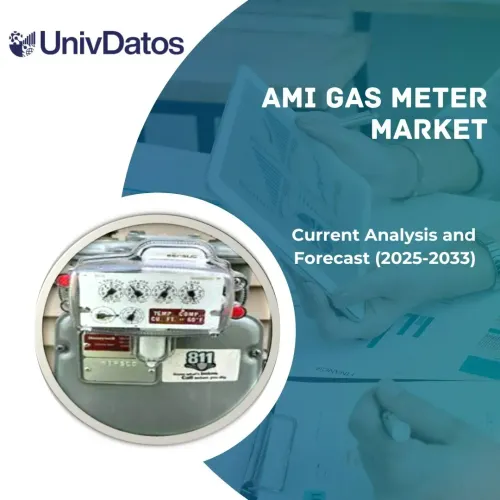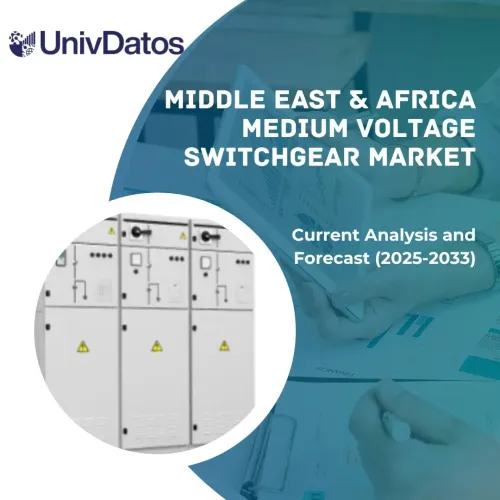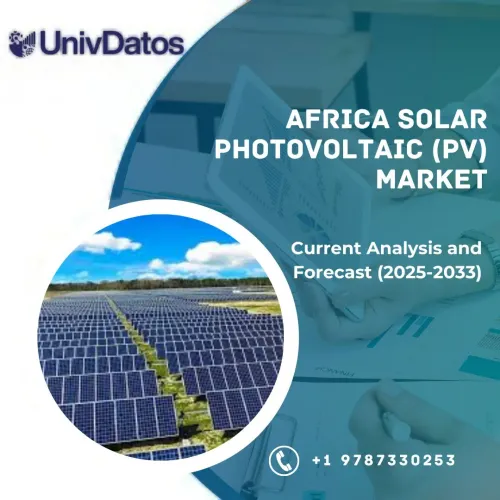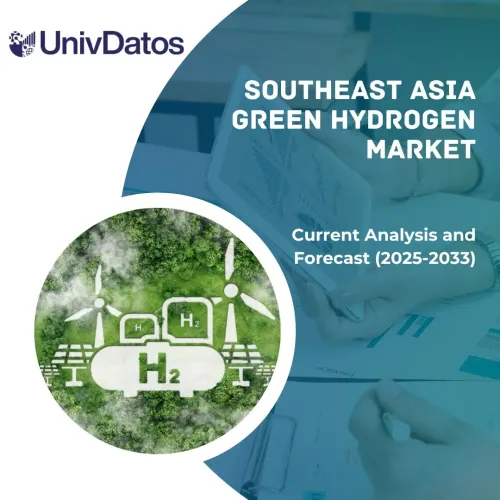- Accueil
- À propos de nous
- Industrie
- Services
- Lecture
- Contactez-nous
Marché de l'encapsulation solaire : Analyse actuelle et prévisions (2023-2030)
Accent mis sur la technologie (couches minces, silicium multicristallin et silicium monocristallin) ; utilisateur final (résidentiel, commercial et industriel, et à l'échelle des services publics) ; matériau (éthylène-acétate de vinyle, acétate de vinyle non éthylénique, résine durcissable aux UV et autres) ; et région/pays
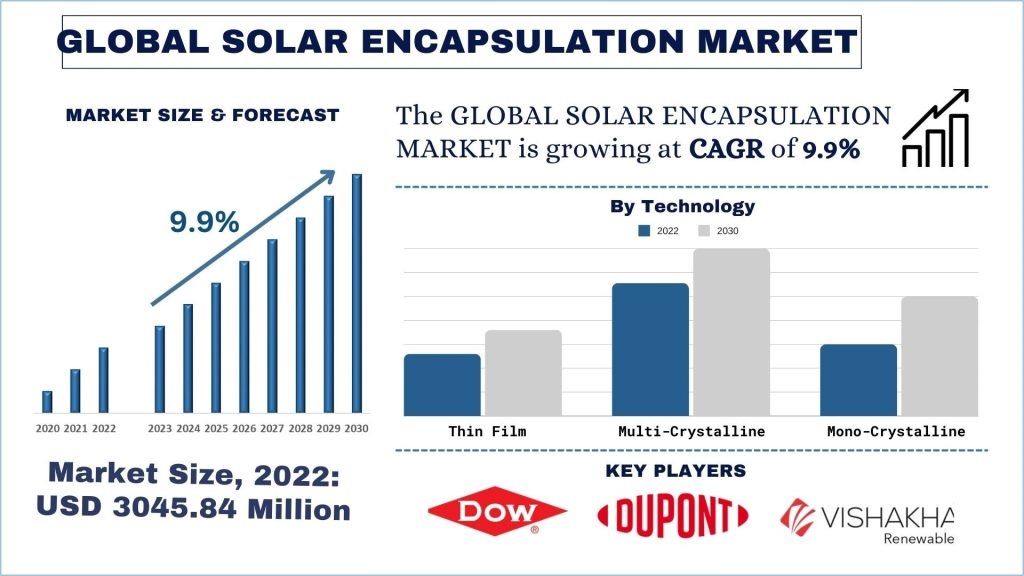
Le marché mondial de l'encapsulation solaire devrait croître à un rythme important d'environ 9,9 % au cours de la période de prévision. Des facteurs tels que l'augmentation de la demande énergétique mondiale, l'épuisement des réserves terrestres et en eaux peu profondes, les technologies innovantes, telles que les appareils de forage avancés, les systèmes de production sous-marine et les techniques améliorées de récupération du pétrole, les prix élevés du pétrole et du gaz, la diversification économique, les politiques gouvernementales favorables et la transition vers les énergies renouvelables sont quelques-uns des facteurs qui stimulent le marché mondial de l'encapsulation solaire.
L'US Energy Information Administration (EIA) rapporte qu'en juillet 2022, 98,8 millions de barils par jour (b/j) de pétrole et de combustibles liquides ont été consommés dans le monde, ce qui représente une augmentation de 0,9 million de b/j par rapport à juillet 2021. En outre, la production quotidienne moyenne de pétrole et de combustibles liquides dans le monde en 2022 devrait être d'environ 99,4 millions de barils, soit une augmentation de 2,1 millions par rapport à 2021.
First Solar Inc., H.B. Fuller Company, Dow Inc., Dupont, Mitsui Chemicals, 3M, JA Solar Technology Co., Renewsys India Pvt Ltd, Exxon Mobil Corporation et Vishakha Renewables Pvt. Ltd. sont quelques-uns des principaux acteurs du marché. Ces acteurs ont entrepris plusieurs fusions et acquisitions ainsi que des partenariats pour faciliter l'accès des clients à des produits/technologies de haute technologie et innovants.
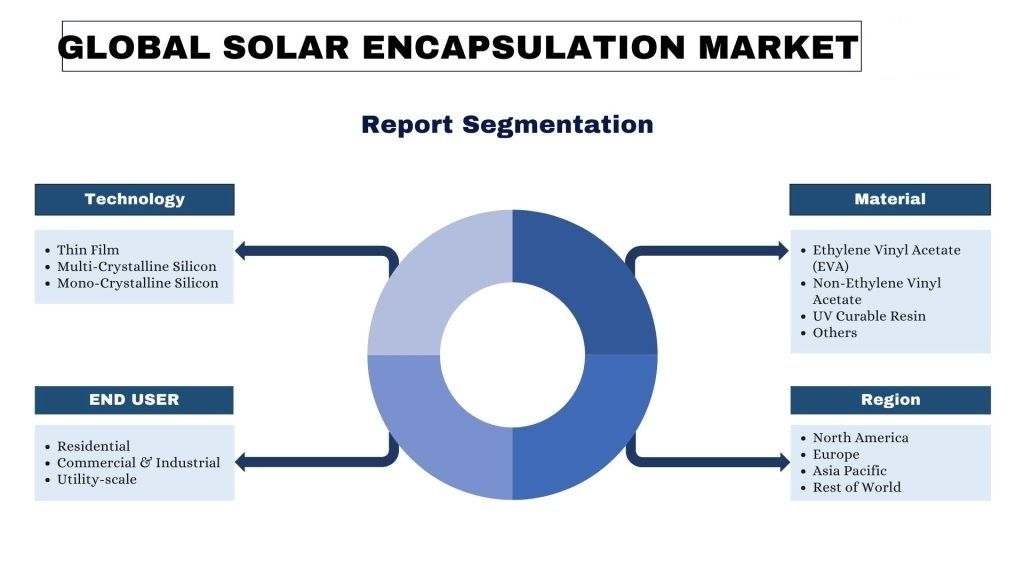
Aperçus présentés dans le rapport
« Parmi les technologies, la catégorie des navires de forage devrait connaître le TCAC le plus élevé au cours de la période de prévision. »
Sur la base de la technologie, le marché est divisé en silicium en couches minces, silicium multicristallin et silicium monocristallin. Le segment monocristallin a dominé le marché en 2022 et devrait connaître la même évolution au cours de la période de prévision. Le passage à un PV solaire monocristallin plus efficace s'est accéléré en 2021, la technologie capturant la quasi-totalité de la production de PV cristallin. Les panneaux monocristallins sont relativement plus efficaces sur le plan énergétique et résistants à la chaleur, mais en même temps, ils sont plus chers et laissent une empreinte carbone élevée lors de leur fabrication. D'autre part, les panneaux multicristallins sont plus abordables mais offrent une efficacité énergétique moindre. Les panneaux solaires monocristallins sont préparés à partir d'un seul cristal de silicium de haute priorité. Ces panneaux ont gagné en popularité ces derniers temps car ils offrent une efficacité, une résistance à la chaleur et une production d'énergie plus élevées. De plus, ces panneaux ont un cycle de vie plus long et durent généralement plus longtemps que leur date d'expiration. Ces panneaux offrent le rendement de conversion photoélectrique le plus élevé, soit environ 18 à 24 %, ce qui en fait un choix intéressant pour les installations commerciales, résidentielles et industrielles. Toutes les pièces métalliques, 85 % des plaquettes solaires et 95 % du verre utilisés dans les panneaux solaires monocristallins sont recyclables. La demande de recyclage des panneaux solaires monocristallins captera la plus grande part de marché, car ces panneaux ont été largement utilisés dans le monde entier et ont été largement adoptés au cours des dernières années.
Par exemple, ReProSolar, en partenariat avec ROSI, a remporté 4,8 millions d'euros de l'UE pour établir une usine pilote de recyclage capable de traiter 5 000 tonnes de panneaux par an d'ici 2023. ROSI utilise un procédé chimique pour le recyclage du silicium cristallin en Europe.
« Parmi les utilisateurs finaux, le segment à l'échelle des services publics détiendra une part importante du marché en 2022. »
Sur la base de l'utilisateur final, le marché est divisé en résidentiel et commercial et à l'échelle des services publics. est divisé en segments résidentiel, commercial et industriel et à l'échelle des services publics. Le segment à l'échelle des services publics a acquis une part majoritaire sur le marché de l'encapsulation solaire et devrait afficher un taux de croissance substantiel au cours de la période de prévision. Le PV à l'échelle des services publics reste la source de production de PV la plus compétitive au monde ; cependant, la construction d'installations à grande échelle devient de plus en plus difficile dans de nombreuses régions du monde en raison du manque de sites appropriés. De plus, le PV solaire est le principal choix du secteur privé s'il souhaite investir dans les énergies renouvelables.
« Parmi les matériaux, le segment de l'éthylène-acétate de vinyle (EVA) détiendra une part importante du marché en 2022. »
Sur la base du matériau, le marché est divisé en éthylène-acétate de vinyle (EVA), acétate de vinyle non éthylène, résine durcissable aux UV et autres. Le segment de l'éthylène-acétate de vinyle (EVA) détient une part de marché importante en 2022 et devrait afficher la même tendance au cours de la période de prévision. Cela est principalement dû à l'adoption précoce et aux excellentes propriétés de protection, même dans les environnements difficiles du matériau. Cependant, avec la prévalence de nouveaux matériaux, la part de marché du segment devrait diminuer au cours de la période de prévision. Le segment de l'éthylène-acétate de vinyle (EVA) est dominant sur le marché mondial de l'encapsulation solaire, ce qui stimule son adoption généralisée. Les encapsulants EVA sont la norme de l'industrie depuis des décennies, offrant une gamme d'avantages qui en font un choix intéressant pour les fabricants de modules solaires. Les encapsulants EVA offrent une excellente transparence optique, permettant une transmission maximale de la lumière aux cellules solaires et améliorant ainsi l'efficacité de la production d'énergie. De plus, ils offrent des propriétés d'adhérence supérieures, assurant une liaison sécurisée entre les cellules solaires et les composants du module et empêchant la délamination et la pénétration d'humidité.
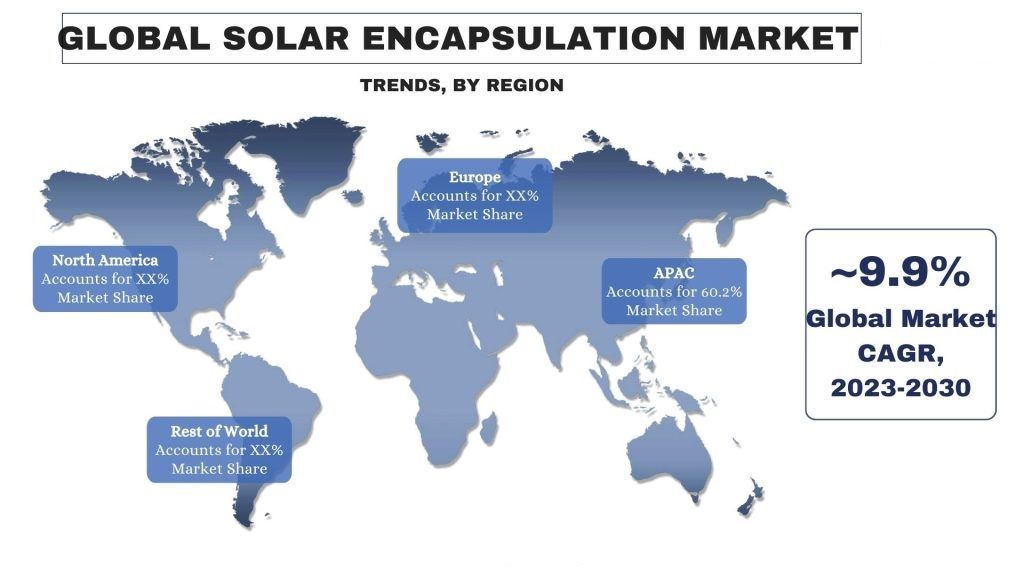
« La région Asie-Pacifique détiendra une part considérable du marché. »
La région APAC a enregistré la part de marché la plus élevée dans le domaine de l'encapsulation solaire et devrait connaître un TCAC influent au cours de la période prévisionnelle. Cela est principalement dû aux nombreux projets de cellules solaires photovoltaïques (PV) qui se déroulent en Chine, en Inde, en Australie et au Japon. De plus, les politiques gouvernementales favorables, les réglementations et les investissements dans la réalisation des objectifs en matière d'énergies renouvelables fixés par divers pays stimulent le marché.
Par exemple : en Australie, le gouvernement australien fournira 14 millions de dollars australiens pour soutenir le projet stratégique d'innovation technologique de 5B, d'un montant de 33,4 millions de dollars australiens, par l'intermédiaire de l'Agence australienne des énergies renouvelables ; au Japon, le gouvernement japonais a alloué 8 milliards de yens dans le budget national de 2021 pour soutenir l'introduction d'équipements indépendants de production d'énergie solaire et de batteries de stockage, y compris les véhicules électriques, par le biais de PPA sur site ; et en Inde, le gouvernement indien a annoncé un apport de capital supplémentaire de 10 milliards de roupies à la Solar Energy Corporation of India et de 15 milliards de roupies à l'Indian Renewable Energy Development Agency.
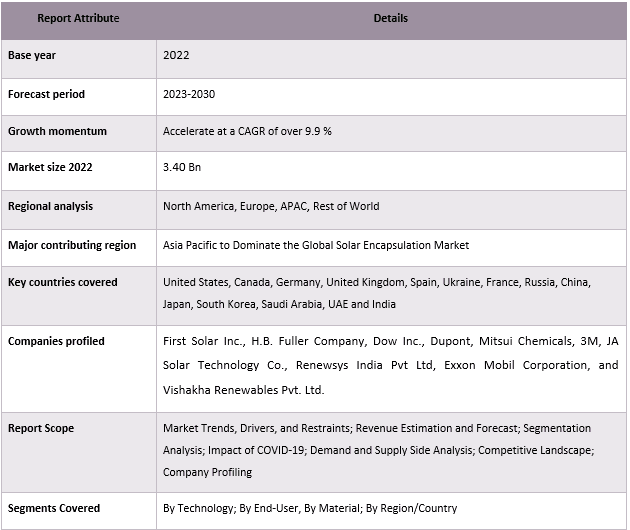
Raisons d'acheter ce rapport :
- L'étude comprend une analyse de la taille du marché et des prévisions validée par des experts authentifiés de l'industrie.
- Le rapport présente un aperçu rapide de la performance globale de l'industrie en un coup d'œil.
- Le rapport couvre une analyse approfondie des principaux pairs de l'industrie, en mettant l'accent sur les principales données financières de l'entreprise, le portefeuille de produits, les stratégies d'expansion et les développements récents.
- Examen détaillé des moteurs, des contraintes, des tendances clés et des opportunités qui prévalent dans l'industrie.
- L'étude couvre de manière exhaustive le marché à travers différents segments.
- Analyse approfondie au niveau régional de l'industrie.
Options de personnalisation :
Le marché mondial de l'encapsulation solaire peut être davantage personnalisé en fonction des besoins ou de tout autre segment de marché. En outre, UMI comprend que vous pouvez avoir vos propres besoins commerciaux, n'hésitez donc pas à nous contacter pour obtenir un rapport qui corresponde parfaitement à vos besoins.
Table des matières
Méthodologie de recherche pour l'analyse du marché de l'encapsulation solaire (2023-2030)
L'analyse du marché historique, l'estimation du marché actuel et la prévision du marché futur du marché mondial de l'encapsulation solaire ont été les trois principales étapes entreprises pour créer et analyser la prévalence croissante et le scénario actuel dans les principales régions du monde. Une recherche secondaire exhaustive a été menée pour collecter les chiffres du marché historique et estimer la taille actuelle du marché. Deuxièmement, pour valider ces informations, de nombreuses conclusions et hypothèses ont été prises en compte. De plus, des entretiens primaires exhaustifs ont également été menés avec des experts de l'industrie tout au long de la chaîne de valeur du marché mondial de l'encapsulation solaire. Après l'hypothèse et la validation des chiffres du marché par le biais d'entretiens primaires, nous avons utilisé une approche descendante/ascendante pour prévoir la taille totale du marché. Par la suite, des méthodes de ventilation du marché et de triangulation des données ont été adoptées pour estimer et analyser la taille du marché des segments et sous-segments de l'industrie concernée. La méthodologie détaillée est expliquée ci-dessous :
Analyse de la taille du marché historique
Étape 1 : Étude approfondie des sources secondaires :
Une étude secondaire détaillée a été menée pour obtenir la taille du marché historique du marché de l'encapsulation solaire à partir de sources internes à l'entreprise, telles que les rapports annuels et états financiers, présentations de performance, communiqués de presse, etc., et des sources externes, notamment les revues, actualités et articles, publications gouvernementales, publications de concurrents, rapports sectoriels, bases de données tierces et autres publications crédibles.
Étape 2 : Segmentation du marché :
Après avoir obtenu la taille du marché historique du marché de l'encapsulation solaire, nous avons mené une analyse secondaire détaillée pour recueillir des informations sur le marché historique et la part des différents segments et sous-segments pour les principales régions. Les principaux segments inclus dans le rapport sont la technologie, l'utilisation finale et le matériau. D'autres analyses au niveau des pays ont été menées pour évaluer l'adoption globale des modèles de test dans cette région.
Étape 3 : Analyse des facteurs :
Après avoir acquis la taille du marché historique des différents segments et sous-segments, nous avons mené une analyse des facteurs détaillée pour estimer la taille actuelle du marché de l'encapsulation solaire. De plus, nous avons effectué une analyse des facteurs à l'aide de variables dépendantes et indépendantes telles que la technologie, l'utilisateur final et le matériau de l'encapsulation solaire. Une analyse approfondie a été menée des scénarios d'offre et de demande, en tenant compte des principaux partenariats, fusions et acquisitions, expansion commerciale et lancements de produits dans le secteur du marché de l'encapsulation solaire à travers le monde.
Estimation et prévision de la taille actuelle du marché
Détermination de la taille actuelle du marché : Sur la base des informations exploitables tirées des 3 étapes ci-dessus, nous sommes parvenus à la taille actuelle du marché, aux principaux acteurs du marché mondial de l'encapsulation solaire et aux parts de marché des segments. Tous les pourcentages de parts requis, la répartition et les ventilations du marché ont été déterminés à l'aide de l'approche secondaire mentionnée ci-dessus et ont été vérifiés par le biais d'entretiens primaires.
Estimation et prévision : Pour l'estimation et la prévision du marché, des pondérations ont été attribuées à différents facteurs, notamment les moteurs et les tendances, les contraintes et les opportunités disponibles pour les parties prenantes. Après avoir analysé ces facteurs, les techniques de prévision pertinentes, c'est-à-dire l'approche descendante/ascendante, ont été appliquées pour parvenir à la prévision du marché pour 2028 pour différents segments et sous-segments sur les principaux marchés mondiaux. La méthodologie de recherche adoptée pour estimer la taille du marché comprend :
- La taille du marché de l'industrie, en termes de revenus (USD) et le taux d'adoption du marché de l'encapsulation solaire sur les principaux marchés nationaux
- Tous les pourcentages de parts, les divisions et les ventilations des segments et sous-segments du marché
- Les principaux acteurs du marché mondial de l'encapsulation solaire en termes de produits proposés. Également, les stratégies de croissance adoptées par ces acteurs pour concurrencer sur le marché en forte croissance.
Validation de la taille et de la part du marché
Recherche primaire : Des entretiens approfondis ont été menés avec les principaux leaders d'opinion (KOL), notamment les cadres supérieurs (CXO/VP, chef des ventes, chef du marketing, chef des opérations, chef régional, chef de pays, etc.) dans les principales régions. Les résultats de la recherche primaire ont ensuite été résumés et une analyse statistique a été effectuée pour prouver l'hypothèse énoncée. Les contributions de la recherche primaire ont été consolidées avec les résultats secondaires, transformant ainsi l'information en informations exploitables.
Répartition des participants primaires dans différentes régions
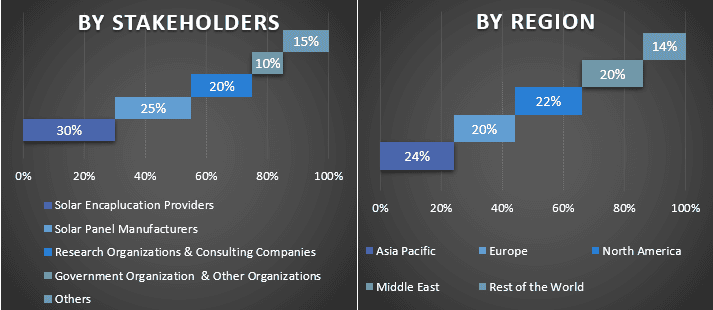
Ingénierie du marché
La technique de triangulation des données a été utilisée pour compléter l'estimation globale du marché et pour obtenir des chiffres statistiques précis pour chaque segment et sous-segment du marché mondial de l'encapsulation solaire. Les données ont été divisées en plusieurs segments et sous-segments après avoir étudié divers paramètres et tendances dans les domaines du type et du processus sur le marché mondial de l'encapsulation solaire.
L'objectif principal de l'étude du marché mondial de l'encapsulation solaire
Les tendances actuelles et futures du marché mondial de l'encapsulation solaire ont été identifiées avec précision dans l'étude. Les investisseurs peuvent obtenir des informations stratégiques pour fonder leur discrétion en matière d'investissements sur l'analyse qualitative et quantitative effectuée dans l'étude. Les tendances actuelles et futures du marché ont déterminé l'attractivité globale du marché au niveau régional, offrant ainsi une plate-forme permettant au participant industriel d'exploiter le marché inexploité afin de bénéficier d'un avantage de premier entrant. Les autres objectifs quantitatifs des études comprennent :
- Analyser la taille actuelle et prévue du marché de l'encapsulation solaire en termes de valeur (USD). Analyser également la taille actuelle et prévue du marché des différents segments et sous-segments.
- Les segments de l'étude comprennent les domaines de la technologie, de l'utilisateur final et du matériau.
- Définir et analyser le cadre réglementaire de l'industrie de l'encapsulation solaire.
- Analyser la chaîne de valeur impliquée avec la présence de divers intermédiaires, ainsi qu'analyser les comportements des clients et des concurrents de l'industrie.
- Analyser la taille actuelle et prévue du marché de l'encapsulation solaire pour la région principale.
- Les principaux pays des régions étudiées dans le rapport comprennent l'Asie-Pacifique, l'Europe, l'Amérique du Nord, le Moyen-Orient et le reste du monde.
- Profils d'entreprise du marché de l'encapsulation solaire et stratégies de croissance adoptées par les acteurs du marché pour se maintenir sur le marché en forte croissance.
- Analyse approfondie au niveau régional de l'industrie
Questions Fréquemment Posées FAQ
Q1 : Quelle est la taille actuelle du marché et le potentiel de croissance du marché mondial de l'encapsulation solaire ?
Q2 : Quels sont les facteurs déterminants de la croissance du marché mondial de l’encapsulation solaire ?
Q3 : Quel segment détient la plus grande part du marché mondial de l'encapsulation solaire par technologie ?
Q4 : Quelles sont les technologies et les tendances émergentes sur le marché mondial de l'encapsulation solaire ?
Q5 : Quelle région dominera le marché mondial de l’encapsulation solaire ?
Q6 : Qui sont les principaux acteurs opérant sur le marché mondial du recyclage de l'énergie solaire ?
Connexes Rapports
Les clients qui ont acheté cet article ont également acheté

